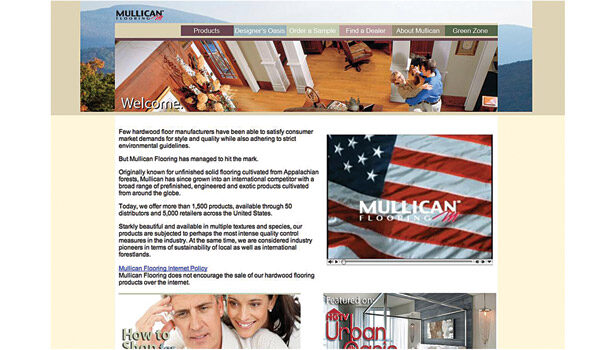Made in the USA: Making More Cents

Carpet industry veteran Bob Weiner is so confident in the advantages of manufacturing in the U.S. he recently opened a new commercial mill in Dalton called Totally Carpet.

Since its founding in 1984, HomerWood has been producing handcrafted Appalachian hardwood flooring in its Titusville Pa., plant—and helps dealers proudly proclaim it on product samples.

In recent years Mullican has been shifting its flooring operations back to the U.S. and a video on its website’s home page lets consumers know the many reasons why they should purchase American made goods.



For many, Made in the USA is a sign of product quality, economic investment and some may even venture to say patriotism, and when it comes to buying floors, consumers’ standards and expectations remain the same.
In an industry that, like others in recent decades, has a history of overseas production, flooring manufacturers are now re-evaluating the costs, time and labor benefits of international production to not only meet the demands and expectations of the U.S. consumer, but in some cases, to cut overall costs.
Put simply, many companies have come to the realization outsourcing is no longer the cheapest route.
In the past, lower international labor and energy costs made manufacturing flooring overseas cheaper for the manufacturer, especially for those producing hardwood, as Brian Greenwell, vice president of sales and marketing for Mullican Flooring, noted. “While overseas manufacturing has always been seen as a cost-saving measure in the manufacturing industry, it is becoming less so in today’s economic climate.”
Recent increases in international labor and fuel costs have made paying for labor and shipping overseas more, or equally expensive as manufacturing products domestically, he said.
“The savings from overseas production is not what it used to be,” Greenwell added, “and the reality is the savings do not outweigh the consumer demand for made in America products. Savings historically seen at overseas plants disappear when you begin factoring in the fuel costs for transporting raw materials and finished products back-and-forth between Asia and the United States.”
HomerWood, a manufacturer that produces handcrafted Appalachian hardwood flooring in Titusville Pa., has been an advocate for domestic production since it was founded in 1984.
“Bringing production back into the U.S. is more financially feasible at this stage, but from our point of view, we’ve never really look at it like that,” said Paul Walker, general manager. “For HomerWood, made in America is a very important part of our value proposition, and it always has been.”
The carpet industry is one flooring sector that has continuously flourished with U.S. manufacturing. “The U.S. carpet industry is still comprised of the most technically advanced, prolific, low-cost manufacturers in the world today. The jobs and manufacturing facilities that started here, stayed here. Today, 80% of all carpet produced for the North American market is produced within a 25 mile radius of Dalton,” says Bob Weiner, industry veteran and founder of the new commercial mill Totally Carpet.
He notes that while China’s emerging carpet manufacturing industry and technology is thriving in the Asia market, he does not believe it will have an impact on the current amount and success of U.S. carpet production.
“As Chinese styling improves and begins to meet U.S. standards, I expect U.S. carpet imports into Asia to diminish,” Weiner added. The expensive freight factor works both ways. Carpet is heavy, expensive and time consuming to ship around the world. I remain doubtful Chinese carpets will have a serious impact on the North American market. Low labor costs are eaten up by trans ocean freight, custom fees, delays, etc.”
Technology is Key
Executives note U.S. technological advancements are helping flooring manufacturers produce top-quality products more abundantly and efficiently, while reducing costs across the board.
“Technology has absolutely allowed the U.S. to be more competitive with overseas markets,” said Greenwell. “By using cutting-edge technology, American manufacturing facilities are able to produce goods more efficiently. The overseas counterparts typically do not have the state-of the-art equipment and, as a result, are unable to match the quality and speed of production we see in the U.S.”
Top of the line technology is also helping companies manufacturing in the U.S. have a faster product turnaround time to meet consumer demand.
Weiner pointed out, “Lead times matter. It’s amazing how carpet replacements average every 12 years, but five-week lead-times are too long. It is crazy, but it is true—customers will not want to wait for a product coming from overseas.”
What’s in it for us?
Companies that are manufacturing in the U.S. consider their operation an investment in the country’s economic growth and well-being.
“We spend our money locally and we provide employment locally,” Walker said. “We buy all of our raw materials in the U.S. In fact, most of the mills we buy our raw materials from are within about a 200 mile radius of our plant in Titusville.”
In addition to the economy, the environment is also reaping the benefits of domestic flooring manufacturing.
“Producing in the U.S. leads to a low carbon foot print, producing jobs in the community, all of our manufacturing jobs are fully benefited,” noted Kevin Biedermann, senior vice president of Armstrong residential flooring products. “We are a great input into the [local and overall] economy. We are proud of that at Armstrong.”
Finally there is the aspect of quality over country.
In the grand scheme of things, both manufacturers and consumers can agree that what’s most important is the quality of the products manufactured—wherever that might be.
“Customer sentiment for Made in the USA only goes so far,” Weiner concluded. In the end, “a product’s performance and appeal trumps wherever it was produced.”
Interestingly, this is an area where many executives explained manufacturing their products in U.S. also has its advantages as they are not only producing goods to meet the needs of the end user, they are also making them under stricter quality control laws employed in the U.S. versus most other countries. In fact, this is why American made goods are sought after around the world as more times than not they are better made than their foreign counterparts.
Looking for a reprint of this article?
From high-res PDFs to custom plaques, order your copy today!











